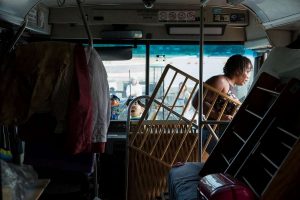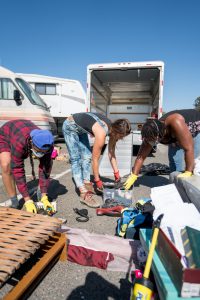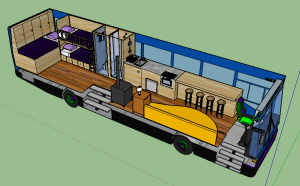Now that the semester has started back at Berkeley and our THIMBY team has returned from their summer adventures spanning from Kenya to Alaska to the San Juan Islands, things are gearing up for a productive fall of prototyping and materials procurement. We purchased large parts of our solar system over the summer to take advantage of a DOE grant reimbursement, ordering 6 285-Watt Solar World panels (a 1.7 kW system), racking, a charge controller, and other associated parts from the Alt-E Store, off-grid solar power and wind energy systems experts. We are currently in the final stages of purchasing a trailer from Carson Trailers via the Tiny House Basics website; our trailer will be 8’ by 24,’ 14k GVWR (gross vehicle weight rating), and deck-over style to facilitate ease of building, available for pickup in about 4 weeks.
As far as prototyping, one important task that will be accomplished this fall is the design and testing of the plant greywater treatment system. The goal of this system is to filter and treat a combination of greywater and rainwater by first skimming off the fats, oils, and solids, and then running the nutrient-laden water through a system of rocks, gravel, sand/soil and plants. The larger leafy plants will use the nutrients, soil will filter out contaminants, and cleaner water running through the system can be used to grow plants for food consumption (the “salad bar” end of the system).
The inspiration for the household plant greywater treatment system comes from many sources, including New Mexico-based Earthship “biotecture” home designs, and from the sustainable living styles of many community members on Lopez Island, Washington. I spent the summer living and working on a farm on Lopez as a sustainable agriculture intern, and in addition to growing and harvesting hundreds of pounds of veggies each week, had the opportunity to visit and learn from various tiny house dwellers and green building enthusiasts on the island. Sandy Bishop and Rhea Miller, directors of the Lopez Community Land Trust, have a plant greywater treatment system in their home that filters and treats about 20 gallons of greywater daily, designed based of the Oasis system. Besides the purification provided by the plants, their filter system includes activated charcoal to eliminate odors, a UV filter, and a pump to channel treated water for reuse.
Examples from Lopez abound on sustainable materials use and sustainable ag. It is an island known for its farming community, a growing network of at least 26 farms (and counting) that work towards the goal of making Lopez an entirely self-sufficient “foodshed.” The lessons of self-sufficiency and environmental land ethic that can be learned from the island translate well to tiny house design and construction. Islands are inherently geared to be more resilient and closed-loop in their consumption and production processes, as our tiny house will need to be in order to function as “off-grid.” It is exciting to think about how our summer research and adventures will shape our work this fall back on campus!
— Laney








